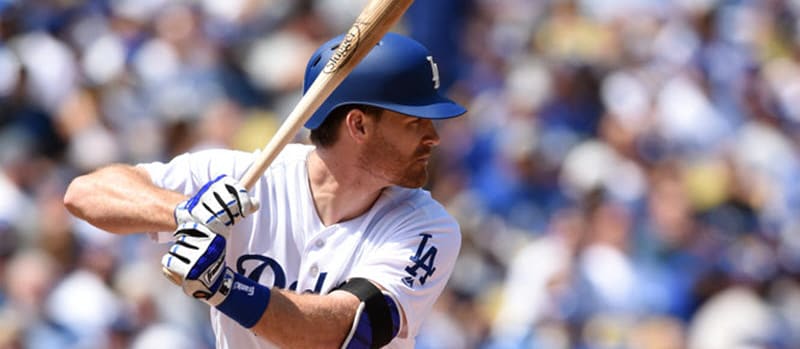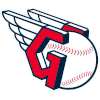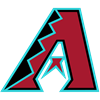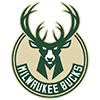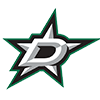Arizona Diamondbacks
First, the humidor news is a game changer. ESPN's Derek Carty posted a ton of great information on this topic on Twitter the other day, so you must read this thread. The one that stood out was the impact the humidor had in Coors Field on home runs:

A 22 percent reduction in home runs is dramatic, and it would have cost Paul Goldschmidt four home runs at home, which would have given him an even 16 at home as well as on the road. Dr. Alan Nathan has said the impact would be somewhere from 25 to 50 percent, which could make the impact even more.
Goldschmidt, over the course of his career, looks rather split neutral with a .299/.411/.548 slash line at home and a .298/.388/.516 slash line on the road. He has been beasting at home in recent years with two seasons of an OPS more than 1.000 in the last three years. Simply put, the humidor is adjusting offensive projections down and pitching predictions up.
Arizona Diamondbacks
First, the humidor news is a game changer. ESPN's Derek Carty posted a ton of great information on this topic on Twitter the other day, so you must read this thread. The one that stood out was the impact the humidor had in Coors Field on home runs:

A 22 percent reduction in home runs is dramatic, and it would have cost Paul Goldschmidt four home runs at home, which would have given him an even 16 at home as well as on the road. Dr. Alan Nathan has said the impact would be somewhere from 25 to 50 percent, which could make the impact even more.
Goldschmidt, over the course of his career, looks rather split neutral with a .299/.411/.548 slash line at home and a .298/.388/.516 slash line on the road. He has been beasting at home in recent years with two seasons of an OPS more than 1.000 in the last three years. Simply put, the humidor is adjusting offensive projections down and pitching predictions up. The strategy, though, it to pay attention to how much the values are adjusted if your league overreacts to the effect and prices fall dramatically. For example, if Yasmany Tomas stalls at $8 in your auction, do not let it stay there because he is still a 20-plus homer threat. Conversely, if the bidding for Robbie Ray gets into the 20s, as much as I like him, I am out.
Ketel Marte (ADP 357th) will steal 20 bases: Marte had some interesting skills growth last year in that he made more contact and did an excellent job of accepting walks while hitting down in the lineup. Despite the jump in on-base percentage from .287 to .345, his stolen-base attempts went from 16 to 13 if you combine his attempts at Triple-A and the majors. 2015 saw Marte steal 28 bases in 34 attempts between Triple-A and the majors, but those attempts have declined since moving to Arizona. 2016 correlated to the fact he simply could not get on base, but last year was a bit surprising because one would think teams would be inclined to run more down in the lineup in case the pitcher does something with a batted ball. Then again, if there are two outs, that runner is going to be anchored on first base because nobody wants the pitcher to lead off the inning.
The run environment in Arizona is going to change because the numbers show the home runs will decrease. Arizona is already aggressive on the bases, as it led the league in extra bases taken percentage and was second in overall stolen base percentage.Carty also noted that in the first year of the humidor in Coors Field, steals went up 18 percent. Lastly, we should not forget how fast Marte is. StatCast sprint speed has him as the fourth-fastest player at shortstop in baserunning spring speed behind Amed Rosario, Trea Turner and Wilmer Difo:

The speed is there, the on-base opportunities are there, but he is somewhat limited by hitting eighth and being anchored at first base with two outs and the pitcher hitting behind him. Two years ago, you could knock the bat out of his hand, but he has re-worked his swing and is not the pushover at the plate he once was. I'm betting he gets moved up in the lineup as the season goes on and his opportunities to utilize his speed for stolen bases grows.
Patrick Corbin (ADP 251) still has an ERA higher than 4.00: This is a bold prediction against the backdrop of the humidor news, but hear me out. Corbin does indeed have a lot of solid skill indicators on the surface: above-average strikeout rate, high groundball rate and a solid walk rate. He had one season in which his ability to strand runner suffered but has otherwise done a good job of stranding baserunners. His ERA has been higher than 4.00 each of the last two seasons because he has had trouble with the long ball as the league changed its approach to launching balls. The humidor is going to help reduce his home-run rate, but we are still talking about a pitcher that has allowed 1.5 baserunners an inning the last two seasons.
Corbin is a three-pitch guy, but the mixture depends on to whom he throws. He is very tough against lefties with the fastball and slider and has struck out 30 percent the last two seasons and has held them to a low batting average. He was particularly nasty against lefties in 2017, allowing a .216 average with a 31 percent strikeout rate and a five percent walk rate. It is a different story against righties as the strikeout rate drops to 19 percent, the walk rate goes up to eight percent, and the batting average against jumps to .289. He has toyed with a changeup in recent years to do something to offset the advantage righties have against him, but it has been a terrible pitch for him by pitch value:
| SEASON | 4FB | 2FB | CH | SL |
| 2016 | -15.1 | 0.6 | -7.9 | 1.3 |
| 2017 | -12.3 | -6.8 | -6.6 | 13.4 |
The year-to-year correlation between pitch values is not strong, but back-to-back large negative run values are not great. Corbin also mentioned to The Athletic's Eno Sarris late last year that he was going to shelve the changeup because it just was not working well for him. If Corbin is going to move forward with a two-pitch pattern, it is tough to see the numbers against righties improving. Last year, he had a .289 average and a 1.53 WHIP against righties, but the 76 percent strand rate helped limit the damage. His overall success hinges on his ability to strand the righties as he puts many on base. It worked well last year (76 percent) but not so well in 2016 (64 percent). When it worked, his ERA was 4.03, and when it did not, it was 5.15. If we split the difference and account for the humidor, it still gives us the potential for an ERA right where it was last year. A lot of people are going to be excited about Arizona pitchers in 2018 due to the change in run environment, but this is the one guy in the rotation I am least excited about.
Colorado
Ryan McMahon (ADP 372) is a top-20 first baseman in 2018: We are at the point where batters are reporting to camp, and the Rockies have not looked to the free agent market to add Logan Morrison, Adam Lind or Lucas Duda for first base. Morrison makes a ton of sense there, but to me, this speaks to their confidence in McMahon as the team has thrown the money to the bullpen, and appears to be quite comfortable letting the kid handle the position despite just 24 big-league plate appearances. McMahon took advantage of the high run environments of the minor leagues and mashed last year in Double-A and Triple-A while playing first base, second base and third base.
He made some changes at the plate to improve his swing, and the work has made him a top-100 prospect in every source that puts out such a list for this coming year. The positional flexibility assures him of a 25-man roster spot, and he has more experience as a defender at first base than Ian Desmond. McMahon has the versatility to get his at-bats at multiple positions, so his bat gets the chance to play even if it is not full time. Pat Valaika was a similar player in 2017 last year as he hit 13 homers in 195 at-bats in favorable matchups, and that could be McMahon's role for 2018. This prediction is the boldest of the ones for this division, but he has the skills to make it happen.
German Marquez (ADP 344) finishes in the top 60 for starting pitchers: He is ranked 85th in our projections at the position. Marquez had a solid first full season in the majors last year with an above-average strikeout rate and an average walk rate. The oddness of his stat line last year was that he was a better pitcher in Coors than on the road. He held batters to a .257 batting average and a .310 on-base percentage at Coors, but the 15 homers in 80.1 innings led to a 4.59 ERA at home. His 4.19 ERA on the road was better, but batters hit .283 against him and had a .353 on-base percentage in that environment.
The reason I am most intrigued about Marquez is that the Rockies invested heavily in their bullpen for 2018. This should mean that Marquez can get out of his way and utilize the run support and the bullpen to increase his 2018 win total while improving his ratios even if it means a reduction in strikeouts. Much of his damage last year came when Colorado left him in the game too long.
| THRU ORDER | TBF | ERA | ER | HR | AVG | OBP | SLG |
| 1st time | 261 | 2.86 | 20 | 8 | .244 | .301 | .400 |
| 2nd time | 259 | 4.83 | 32 | 7 | .269 | .345 | .476 |
| 3rd time | 176 | 6.16 | 26 | 10 | .313 | .364 | .588 |
If we eliminated the bottom numbers from his overall production last year, he has a 3.82 ERA, 110 strikeouts in 122.2 innings and has limited batters to a .256 average with a 1.30 WHIP. Any of us would take those numbers from a Colorado pitcher all day long, especially in NL-Only leagues. The extra exposure to the lineup added more than half a run to his ERA and another 40 points to his slugging percentage. By utilizing the expensive bullpen the team has assembled, it can limit Marquez's exposure to lineups a third time through and improve his ratios as well as his opportunities for wins. He won 11 of 29 outings last year, despite eight no decisions in quality starts. Fifteen wins, a sub 4.00 ERA with a decent amount of strikeouts is possible. I have four teams assembled for 2018 – 2 NL-Only keeper leagues, mixed LABR, and an NFBC draft and hold – and Marquez is on all four of those rosters.
Los Angeles
Logan Forsythe (ADP 430) finishes as a top-20 second baseman: In 2017, Forsythe was the 18th second baseman by ADP, going as high as 80 (wasn't me) in drafts and as low as 313 with an overall ADP of 221. This year, he is eligible at both second base and third base and has been drafted no higher than 328, as low as 351, and even undrafted in 32 of the NFBC's 135 drafts. Forsythe broke his toe in late April and got Wally Pipp'd when Chris Taylor took over the playing time and never looked back.
Forsythe had his issues against right-handed pitching while he played with San Diego and even his first season with Tampa Bay, but did rather well against them in both 2015 and 2016 as he built up his overall value. Last season, he had his worst overall season against righties regarding batting average and never set a career low in strikeout rate against them as well. In short, all the progress he made by 2016 evaporated last year:
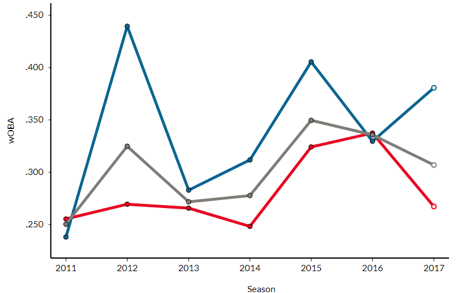
Even in a season where he struggled overall, he still did his damage against lefties, and that does not appear to be leaving him anytime soon. Forsythe blames the early toe injury for disrupting his timing last year and the struggles against righties. After watching the progress he made in 2015 and 2016 against them over significant sample, I am inclined to believe him. He is slated to be the starter at second base this season with the Silver Fox still in play should Forsythe struggles against righties continue. He is an afterthought in drafts, but it was not that long ago he was a top 15 producer at his position.
Alex Wood (ADP 107) finishes outside the top-60 SP: I take back saying my McMahon prediction was my boldest because this one feels hugely bold. Exhibit A – the stat lines below:
| SEASON | K% | BB% | LOB% | ERA |
| 2014 | 25 | 7 | 80 | 2.78 |
| 2017 | 25 | 6 | 80 | 2.72 |
Each of those lines belongs to Alex Wood. In 2015, Wood saw his ERA jump more than a full run as his LOB% fell to 73 percent and he lost quite a bit of his strikeout rate as it fell eight percentage points. Exhibit B – his first and second-half splits:
| SEASON | K% | BB% | LOB% | ERA |
| 1st half | 31 | 7 | 81 | 1.67 |
| 2nd half | 18 | 5 | 80 | 3.89 |
His ERA jumped more than two full runs in the second half of the season despite the fact he was still stranding a lot of runners. Now, I present Exhibit C – his month by month velocity from 2017:
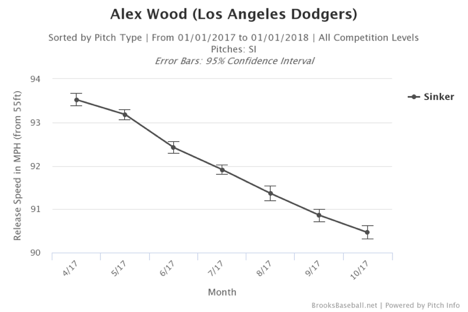
That is the pitch Wood threw 49 percent of the time last year and it limped to the finish line losing a full three miles an hour from April to October.
There are simply too many areas of concern here for me to full freight or even a 10 percent discount for Wood. There were times last year where he looked simply brilliant but the second half looked more like a plunge to reality.
San Diego
Hunter Renfroe (ADP 298) fails to hit 20 homers: He hit 26 last season in 122 big-league games and 30 if you throw in the four homers he hit in 14 games in Triple-A. That comes on the heels of a 30-homer season in Triple-A in 2016. He is built around a pull-heavy flyball approach and is not much concerned with accepting walks or striking out because his game is built around his raw power. He out-performed his expected weighted on-base average last year as well, and our projections have him going deep 26 times again in 2017. It is very tough to overlook his struggles in the second half.
Yes, his second-half slugging percentage was 63 points higher than what he did in the first half, but it came at the expense of a terrible 0.11 BB/K ratio. That ratio was a decline from what was already awful 0.23 BB/K. Renfroe was also just slightly above league average regarding Barrels/Plate Appearance, and his average exit velocity was in the 40th percentile and equal to the likes of Tim Beckham, Chris Iannetta, Tyler Moore, Eric Thames and Ian Happ. The range of outcomes there is wide, but given the extreme range of his walks and strikeouts, one would expect more oomph off his bat if he is up there on such a singular mission. I am betting on the league continuing to use that aggressiveness against him, and him struggling to replicate his one-category production of last year.
Dinelson Lamet (ADP 214) finishes outside of the top-75 SP: We have him 51st with 10 wins, 183 strikeouts, a 3.84 ERA and a 1.24 WHIP in 157 innings. Those are very reasonable projections, but I have a few reasons to push back on them and focus on the lower percentiles of his probabilities.
Lamet is primarily a two-pitch guy with a good fastball and even better slider along with a changeup that shows promise but is terribly inconsistent. The fastball/slider combination allows him to be lethal against righties as he held them to a .239 wOBA (.154/.241/.296 slash line) in 232 plate appearances with a 4:1 strikeout to walk ratio to boot.
The lack of something that goes the other way or at least comes in at a slower break against lefties leaves him quite exposed, and he had a .364 wOBA (.258/.365/.502 slash line) against lefties in 232 plate appearances. A 135 point split in wOBA is typically the stuff that relievers come from, but Lamet's stuff shows enough promise that San Diego needs to leave him in the rotation until he proves otherwise.
The two-pitch repertoire also leaves him susceptible to exposure through the order, which is where my issue with him lies.
| THRU ORDER | TBF | AVG | OBP | SLG | K-BB% | BABIP | ERA |
| 1st time | 189 | .156 | .254 | .347 | 25 | .202 | 3.94 |
| 2nd time | 189 | .201 | .307 | .348 | 16 | .264 | 3.22 |
| 3rd time | 105 | .304 | .394 | .596 | 8 | .333 | 8.86 |
The problem should be simple enough to fix if the Padres just yank him out earlier in 2018. The problem with that theory is Lamet is not pitch efficient as he averaged 4.0 pitches per plate appearances last season while the average starter (min 100 IP) was at 3.88. The fact Lamet earned a decision in 15 of his 21 outings in the majors last season is encouraging, but he was just 3-6 in the 11 games in which he pitched fewer than six innings and won three of his 12 starts in which he was allowed to face the cleanup hitter a third time.
Which path will the Padres walk in 2018? The one that will greatly improve his ratios, but impact his strikeouts and wins, or the one that pushed up his strikeouts a bit, but continues to hurt his ratios for the chance at a few more wins? I am coming at this from someone who has him at $6 in my NL-only league and am honestly not expecting much of a profit on that investment.
San Francisco
Evan Longoria hits fewer than 15 homers: There were 73 home runs hit by right-handers in AT&T Park in 2017, 23 of which came from the home team. No right-handed Giants hitter had more than four homers at home last year and only four – Nick Hundley, Hunter Pence, Buster Posey and Christian Arroyo – had multiple home runs at home. AT&T Park is the toughest park in the majors regarding home run park factors for right-handed batters. Tropicana Field was not a great place for RH homers (93/100), but this is a big step back. Now, it might not be reflected in his slugging percentage because Longoria, when he is going well, will wear out the gap in right-center field. AT&T Park will be nice for him in that regard, but it will be a challenge for him to avoid setting a career low in homers.
The last four seasons, his HR/FB ratio has been 11, 11, 15 and 11 percent. The one year it spiked, his home run total reached 36. The three years it did not spike, his home run total was 20-22. Sure, he'll get some games in Coors Field now, but he also enjoyed games in havens such as Fenway Park and Camden Yards while in the AL East. In fact, every park on the road for him within the division was a positive change for him compared to home. That does not hold up in the NL West where he plays in a pitchers' park, has two more to visit in Los Angeles and San Diego and now has a neutered environment in Arizona.
Chris Stratton finishes as a top-75 SP: Stratton is 181st in our pitcher rankings but is 209th among pitchers in NFBC rankings. He was 4-4 with a 3.68 ERA last year, a 20 percent strikeout rate and a nine percent K-BB%, but he closed strongly as he went 4-2 over his final eight outings with a 2.27 ERA, a 23 percent strikeout rate and a 14 percent K-BB%.
Stratton's success does not come from his average velocity fastball, rather from his incredibly high-spin curveball. His curveball has a 3,105 rpm, making it the highest spin-rate curveball in the league. It is a work of art against which the league hit .116 and hit groundballs 56 percent of the time (per pitcherlist.com).
Strangely, Stratton does not use the pitch as much as one would assume because he appears to be more interested in setting up the relievers behind him as he told Eno Sarris in August:
"As a starter I feel like I have to throw more fastballs especially to set up for the relievers coming in late," Stratton explained to me this week, "because if all they see is breaking pitches early, if they need to come in and get a punchout, I'd rather they hadn't seen breaking pitches all game."Stratton's fastball is a high-spinner as well, just not as much as his curveball, yet it is enough to make his fastball more playable. There is a 45-point split in his wOBA (.348 vs LH, .303 vs RH) in his short career, which has encompassed all of 299 batters faced, but the fact he throws four pitches should narrow that gap as he improves his changeup. As it were, he had two 10-strikeout games in August against Washington and Arizona and ended the season with a seven-strikeout performance against San Diego. He is there for the taking in any draft format and could end the season with positive value in 15-team mixed formats if things break the right way for him. The pieces are there for it to happen.


